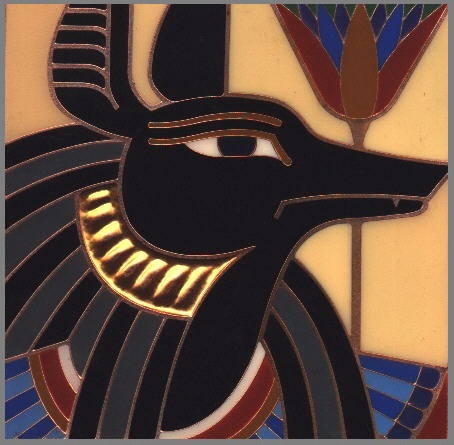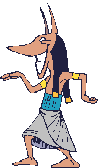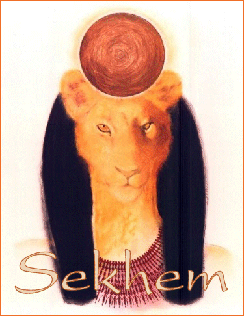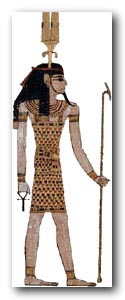Welcome | Wepwawet
| Sekhmet | Who is Senyt-menu?
| Hymns & Prayers
Festivals | Ancestor
Veneration |Related Links
![]()
ii-wy em hotep
Welcome in peace!

I am called Senytmenu (seh-neet meh-noo),
which in the Kemetic (ancient Egyptian) language means "The Two endure."
My nickname is Senut (seh-noot). "The Two" refers to my
Spiritual Parents, Sekhmet and Wepwawet,
and this website is my tribute to Them.
I am a member of The House of Netjer, a Kemetic Orthodox temple that teaches and practices the ancient Egyptian religion. For more information about me and the story of how I came to my religion, please refer to Who is Senytmenu? on this website.
In Kemetic Orthodoxy, God is called Netjer, the One and the Many. We believe that God can be understood and manifest in more than one aspect. This is a special type of polytheism known as "monolatry," which permits a multi-god structure while allowing the concept that all divine beings are part of one divine Source. If this sounds a little mind-boggling, consider the Christian Trinity concept where the Father, Son and Holy Spirit are all part of the definition of "God," yet can be addressed and prayed to separately. For more information on Kemetic Orthodoxy and its practice, click here.
Also, the term "orthodoxy" in our temple's name simply means that we do not blend other religious concepts into our own tradition. We don't condemn those who do; everyone must go by their own personal gnosis in such matters. However, the ancient Egyptian priests were very literate and left many records behind on the practice of their religion, and this is what House of Netjer relies on in its own practice. In this sense it is not a "reconstructed religion" because we have access to actual written instructions on the practice of the ancient Egyptian religion, and so we don't have to guess at or make up things as to how we think it may have been practiced.
Contrary to what some may think, the ancient
Egyptians did not worship animals, although some were considered sacred
in the way that cattle are respected in India because of their association
with the Hindu god Brahma. Some Egyptian deities have animal forms (or are
animal-headed) because of certain traits an animal may have that relates
to the function of the deity. For example, Yinepu (Gr. Anubis) is associated
with death rites and the Afterlife. He was originally portrayed as a jackal
because jackals were often seen around places of burial. Another example
of sacred animal traits can be found in Christianity: Jesus is called the
Lamb of God for his meekness and sacrifice, and is in fact depicted as a
lamb in some forms of religious art. This doesn't mean that Christians worship
sheep.
The following information is based upon my own personal experiences and research, and is by no means the definitive end-all regarding the qualities of my Spiritual Parents. Can God be contained or completely defined in any one religion? I think not. Behind all the rhetoric and dogma, I believe that it is only our personal relationship with God that matters. And we all experience God differently.
Academic note: I refer to our deities by their Kemetic names. The common or Greek names are listed after the abbreviation of "Gr." in parentheses.

 Wepwawet/Yinepu
Wepwawet/Yinepu
Opener of
the Way
Keeper
of Doorways
Lord of the Crossroads
Master of Beginnings
Wepwawet is one of the oldest-referenced deities in ancient Egyptian history
known as the Opener of the Way. This can apply on the spiritual level where
He facilitates communication with the various Netjeru (gods and goddesses),
or He can work His title in more mundane areas. Kemetic armies often carried
His standard into battle that He might clear a path through enemy ranks.
I have a "dashboard jackal" in my car for safe travel through
traffic. Many also pray for His blessing at the
start of new projects or phases in their lives.
Wepwawet is dual-aspected with Yinepu (Gr. Anubis). He may appear either as a jackal-headed man, or as a standing or reclining jackal, although the reclining position shown on a golden sledge (platform) is mostly used for Yinepu. In appearance Wepwawet is much the same as Yinepu, only He may be brown or gray in color instead of black. A Greek historian once stated that He was supposed to have been a wolf rather than a jackal, and the ancient Romans depicted Him as more wolf-like and grey in color; however, there is no Kemetic confirmation of this theory. Aside from color, the only way one can tell the difference between the two is by the interpretation of the hieroglyphs that accompany the portrait.
Like Yinepu, Wepwawet shares the secretive and wiley nature of the jackal who is also associated with the passage and guardianship of the dead. Unlike Yinepu, He has more to do with the mysteries of magic and intuition, and not so much with funerary aspects. His nature is enigmatic and aloof, yet easy-going and diplomatic. He is perhaps the most pragmatic of the Netjeru; His motto: "Whatever works." He’ll get things done in the most efficient way possible within the boundaries of Ma’at (a term referring to universal order, harmony and balance). Ma'at is also the name of a Netjert (goddess) Who embodies these virtues.
On the lighter side, Wepwawet can be mischievous bordering on the irreverent. He has a sarcastic and wicked sense of humor, and can be compared to the Trickster in some Native American cultures. Sometimes He'll make me work very hard for what He has to teach me, while at other times He'll drop an answer or lesson right in my lap with relative ease. But He never spells things out.
Colors: gray, silver, brown, deep purple.
Offerings: hard liquor (especially dark rum); strongly-flavored, acidic and/or spicy foods; all types of meat (cooked or raw); feathers and smoke (including pungent incense and tobacco).
Religious Affiliations: The Trickster (Native American), Papa Legba (Vodou).

![]()
 Sekhmet/Hethert
Sekhmet/Hethert
Eye of Ra
Great One of Healing
The Beautiful Light
Destroyer by Fire
The
100 names of Sekhmet
Portrait of Sekhmet by Jeff Spencer
![]() In Her corporeal form, Sekhmet is portrayed
as a woman with a lioness’ head wearing the solar disk of Ra as His
daughter. She bears the title of Eye of Ra,
along with the other three daughters of Ra: Bast, Het-hert (Gr. Hathor)
and Aset (Gr. Isis).. Her name is derived from the Kemetic word sekhem,
meaning "power." Fearsome, yes—She is the Enforcer of Ma’at.
But She is also a great Healer and Protector.
In Her corporeal form, Sekhmet is portrayed
as a woman with a lioness’ head wearing the solar disk of Ra as His
daughter. She bears the title of Eye of Ra,
along with the other three daughters of Ra: Bast, Het-hert (Gr. Hathor)
and Aset (Gr. Isis).. Her name is derived from the Kemetic word sekhem,
meaning "power." Fearsome, yes—She is the Enforcer of Ma’at.
But She is also a great Healer and Protector.
In addition to identifying with Heru (Gr. Horus), The pharaohs of Kemet also called themselves by Sekhmet’s title through Her solar identity as Eye of Ra. (Conceptions of God in Ancient Egypt, Erik Hornug, p. 49.) A poem in tribute to the pharaoh Senusert III (Dynasty XII) entitled "The Greatness of the King" states: "How great is the Lord of his city! / He is Sakhmet [sp. var.] against the enemies who test his borders." (Ancient Egyptian Literature: An Anthology, translated by John L. Foster, pp. 94-95.)
Prayers of supplication were made to Her for healing, to protect the pharaoh from the Seven Arrows of the Year which represented the dangers that might afflict Egypt and the pharaoh, such as contagious diseases, plagues and massacres, from all of the year’s noxious flies, that they might not ‘stick’ to him. (Daily Life of the Egyptian Gods, Dimitri and Christine Meeks, p. 131.) The following is an example of such a prayer from the New Kingdom:
Oh Sekhmet, You who love justice and abhor injustice, O Mistress of men, come to King Ptolemy, the living image, the living falcon; save him, guard him, protect him from the sixth arrow of the year! O Sekhmet-Uraeus, You who ‘open the circle,’ O Mistress, come to King Ptolemy, the living image, the living falcon; save him, guard him, protect him from the seventh arrow of the year! (Ibid, p. 131-132)
Sekhmet is also dual-aspected with Het-hert . Her origin is recounted in a story I shall call The Pacification of Sekhmet; it is a generalization of many accounts: Sekhmet was created out of Het-hert by Ra and sent out as His avenging Eye to punish a rebellious faction of humanity that was mocking Him. She was to only diminish the number of these insurgents, but became overzealous in Her task upon discovering that She greatly enjoyed the taste of blood! Fearing that all humanity would be wiped out, Ra devised a plan with Djehuty (Gr. Thoth) to calm Her down. He ordered a large vat of beer stained red with a mineral pigment called ochre (ground hematite in some accounts) to be poured out on the ground near where Sekhmet was carrying on Her devastation. Seeing the red beer and mistaking it for blood, Sekhmet eagerly consumed it. She became quite drunk, of course, and Her rampage against humanity came to an end. This is why red beer is a traditional offering to Sekhmet.
 Sekhmet's
consort and husband is Ptah,
patron deity of artisans and builders. They have a son, Nefertem
(depicted at left), Who is called Lord of Perfumes and appears as a handsome
young man wearing a lotus on His head. He is associated not only with the
making of fragrances and perfumes, but also with healing, like his Mother.
The renowned architect and physician Imhotep
was an avatar of Nefertem.
Sekhmet's
consort and husband is Ptah,
patron deity of artisans and builders. They have a son, Nefertem
(depicted at left), Who is called Lord of Perfumes and appears as a handsome
young man wearing a lotus on His head. He is associated not only with the
making of fragrances and perfumes, but also with healing, like his Mother.
The renowned architect and physician Imhotep
was an avatar of Nefertem.
As a Spiritual
Parent, Sekhmet is direct and blunt; She doesn't sugar-coat Her messages.
She can be stern, especially if you belittle yourself. But She is also loving
and fiercely protective of Her children. She prefers action over words,
and expects us to work hard and make use of our talents in Her service.
"No thing is impossible with Our help," She revealed to me in
my devotions one day.
Colors: red,
gold, bright yellow, orange (colors associated with fire and the sun), and
also white (for Her relationship with Ma’at as Enforcer).
Offerings: frankincense, dragon’s blood incense, raw meat, beer (especially red beer), red wine, warming foods and spices (e.g. ginger, curry), cinnamon, gold, garnet, carnelian, hematite, bloodstone, sand.
Religious Affiliations:
Saint Barbara (Santaria, Vodou).
A gold and lapis lioness head from
the treasures of Tutankhamun
displayed in the Cairo Museum; probably a depiction of Sekhmet.
(Photo by Jeff Spencer)
Festivals | Ancestor Veneration |Related Links